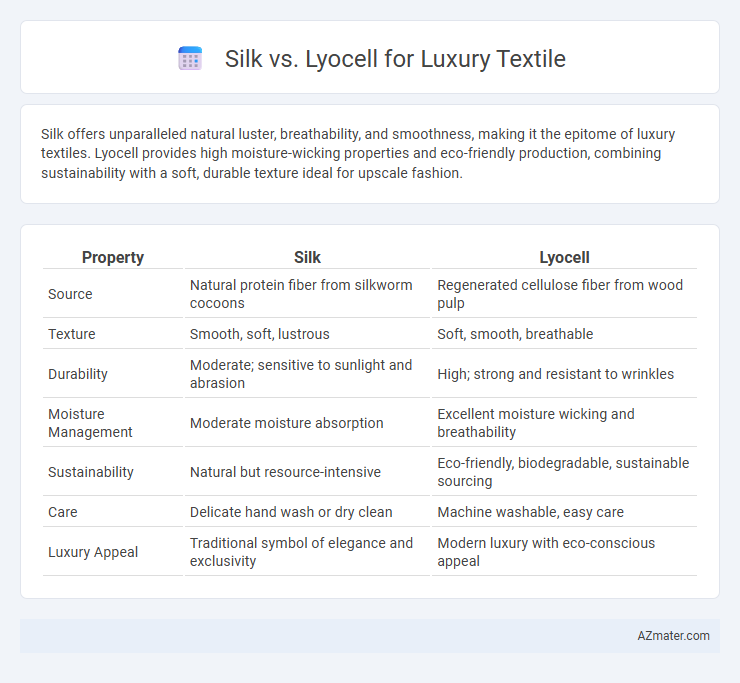Silk offers unparalleled natural luster, breathability, and smoothness, making it the epitome of luxury textiles. Lyocell provides high moisture-wicking properties and eco-friendly production, combining sustainability with a soft, durable texture ideal for upscale fashion.
Table of Comparison
| Property | Silk | Lyocell |
|---|---|---|
| Source | Natural protein fiber from silkworm cocoons | Regenerated cellulose fiber from wood pulp |
| Texture | Smooth, soft, lustrous | Soft, smooth, breathable |
| Durability | Moderate; sensitive to sunlight and abrasion | High; strong and resistant to wrinkles |
| Moisture Management | Moderate moisture absorption | Excellent moisture wicking and breathability |
| Sustainability | Natural but resource-intensive | Eco-friendly, biodegradable, sustainable sourcing |
| Care | Delicate hand wash or dry clean | Machine washable, easy care |
| Luxury Appeal | Traditional symbol of elegance and exclusivity | Modern luxury with eco-conscious appeal |
Introduction to Silk and Lyocell in Luxury Textiles
Silk, a natural protein fiber produced by silkworms, is prized in luxury textiles for its smooth texture, natural sheen, and exceptional breathability. Lyocell, a sustainable fabric derived from wood pulp through an eco-friendly process, offers high moisture absorption, durability, and a soft, silky hand feel that rivals traditional fibers. Both materials are favored in luxury fashion and home textiles due to their comfort, elegance, and versatile performance.
Origins and Production Processes
Silk originates from the larvae of the Bombyx mori silkworm, primarily cultivated in China and India, where the fibers are harvested through a labor-intensive process of carefully unwinding cocoons. Lyocell is derived from sustainably sourced wood pulp, typically eucalyptus, processed via a closed-loop system that minimizes environmental impact by recycling solvents and water. Both materials leverage intricate production methods, with silk emphasizing natural protein filament extraction and lyocell focusing on innovative, eco-friendly cellulose fiber regeneration.
Fiber Structure and Material Composition
Silk fibers, composed primarily of fibroin proteins, exhibit a natural triangular prism structure that refracts light, giving luxury textiles their characteristic luster and smooth texture. Lyocell, derived from cellulose in wood pulp, features a round cross-section and uniform fibril arrangement, resulting in exceptional strength, moisture absorbency, and a soft, breathable feel in high-end fabrics. The protein-based structure of silk contrasts with the cellulose composition of lyocell, influencing their durability, sheen, and suitability for different luxury textile applications.
Environmental Sustainability and Impact
Silk, derived from silkworms, offers natural biodegradability but involves intensive water use and ethical concerns related to sericulture. Lyocell, a cellulose fiber made from sustainably harvested wood pulp, features a closed-loop production process with minimal chemical waste and superior biodegradability. The environmental impact of lyocell is generally lower than silk, making it a preferred choice for luxury textiles prioritizing sustainability and reduced ecological footprint.
Texture, Softness, and Drape Qualities
Silk offers a naturally smooth texture with a luxurious sheen, prized for its exceptional softness and elegant drape that gracefully conforms to body contours. Lyocell, derived from sustainably sourced eucalyptus fibers, provides a silky feel with a matte finish, boasting superior softness and enhanced breathability while maintaining excellent drape and resilience. Both fibers excel in luxury textiles, but silk's natural luster contrasts with lyocell's eco-friendly attributes and moisture-wicking softness.
Breathability and Moisture Management
Silk offers natural breathability and excellent moisture-wicking properties, making it ideal for luxury textiles that require temperature regulation and comfort. Lyocell, derived from sustainably sourced wood pulp, excels in moisture management by absorbing and releasing moisture quickly, keeping the skin dry and cool. Both fibers provide premium breathability, but Lyocell's superior moisture absorption often makes it the preferred choice for active or warm climates in high-end fabric blends.
Durability and Longevity
Lyocell offers superior durability compared to silk, with its strong, moisture-resistant fibers ensuring longer lifespan in luxury textiles. Silk, while prized for its natural sheen and softness, is more prone to abrasion and requires delicate care to maintain its integrity. Choosing lyocell enhances the longevity of high-end fabrics, making it a practical yet luxurious alternative to traditional silk.
Care, Maintenance, and Ease of Use
Silk requires delicate care, typically hand washing with mild detergents or dry cleaning to preserve its natural fibers and sheen. Lyocell offers superior ease of maintenance, being machine washable and wrinkle-resistant, making it ideal for luxury textiles that demand both elegance and practicality. Both fibers provide a smooth, luxurious feel, but Lyocell's durability and moisture-wicking properties enhance long-term usability compared to silk's more delicate nature.
Price Comparison in the Luxury Market
Silk commands a higher price point in the luxury textile market due to its natural fiber origin, labor-intensive harvesting, and exclusive sheen, often ranging from $20 to $50 per yard. Lyocell, derived from sustainably sourced wood pulp and produced through an eco-friendly closed-loop process, offers a more affordable luxury alternative priced between $15 and $30 per yard. The sustainable production of lyocell appeals to eco-conscious luxury brands seeking cost-effective yet premium-feeling fabrics without compromising on softness or drape.
Choosing the Right Fabric for Luxury Applications
Silk offers unmatched softness, natural sheen, and breathability, making it ideal for high-end luxury textiles where elegance and comfort are paramount. Lyocell, derived from sustainable wood pulp, provides exceptional moisture-wicking properties, durability, and a smooth texture, appealing to eco-conscious luxury brands seeking performance and environmental responsibility. Choosing between silk and lyocell depends on prioritizing natural luxury aesthetics versus sustainable innovation in premium textile applications.

Infographic: Silk vs Lyocell for Luxury textile
 azmater.com
azmater.com